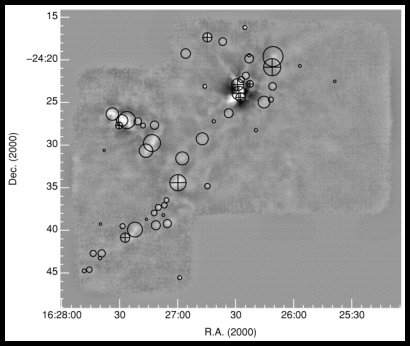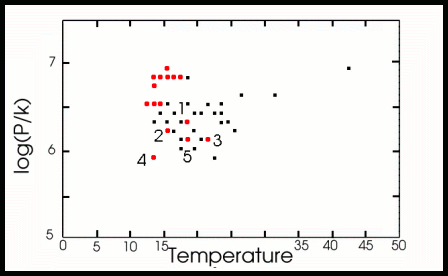Star Formation Scenarios Using Submillimeter Observations
This work was a preliminary examination. More detailed work was carried out subsequently by Doug's graduate student, Helen Kirk, at the University of Victoria.
 The image to the right shows 850 micron SCUBA observations of the Rho Ophiuchus star forming region. This wavelength is sensitive to thermal emission from
cold dust in molecular clouds and hence is a useful band in which to observe star formation. A clump-finding analysis in line with similar
surveys was able to select 55 clumps with column densities above that of the background. These 55 clumps were then modeled as pressure-confined, isothermal
hydrostatic spheres (Bonner-Ebert spheres) in order to be able to assign to them physical parameters: external pressure, temperature and mass.
The image to the right shows 850 micron SCUBA observations of the Rho Ophiuchus star forming region. This wavelength is sensitive to thermal emission from
cold dust in molecular clouds and hence is a useful band in which to observe star formation. A clump-finding analysis in line with similar
surveys was able to select 55 clumps with column densities above that of the background. These 55 clumps were then modeled as pressure-confined, isothermal
hydrostatic spheres (Bonner-Ebert spheres) in order to be able to assign to them physical parameters: external pressure, temperature and mass.
This analysis and modeling revealed two interesting results: most clumps appeared highly stable and not prone to collapse without substantial alterations of their properties (substantial increases in external pressure, accretion of surrounding mass or decreases in their temperature). In the language of Bonner-Ebert spheres the clumps are not concentrated enough to be prone to collapse. The second results concerns the mass-distribution of the clumps. It is already very similar to the Initial Mass Function (IMF) for stars. This can be used a constraint for possible collapse mechanisms.
Using the above-mentioned measurements and analysis as the impetus, we examined possible mechanisms which could trigger the collapse of the observed objects into protostars. The investigation focused on those mechanisms which increase the ambient pressure surrounding the clumps. Two general schemes were classified depending on whether the collapse method was global or local. Global methods such as supernovae blast waves or spiral density waves will pass through the molecular cloud in a relatively short period of time, collapsing all the clumps at approximately the same time. Local methods, such as HII ionization regions or stellar winds from protostars cause a pressure increase in the local area of the protostar thereby triggering the collapse of neighboring clumps. Once these neighboring clumps have collapsed into protostars they may further collapse other clumps.
While we found specific mechanisms, both global and local, which were able to produce the large increases in background pressure required, they all suffered from additional problems. Ionization regions produced surrounding young stars and stellar winds from neighboring protostars would likely not maintain the observed mass distribution since mass accretion would occur for different lengths of time depending when the clumps were collapsed. Since the mass distribution of the clumps is already that of a stellar mass distribution, Occam's razor would suggest that they should remain so regardless of the collapse mechanism at work. Likewise, while supernova blast waves and spiral density waves were also judged to be possible trigger mechanisms, there exists the possibility that they may destroy the clumps rather than collapse them.
More details of the analysis can be found in this PDF file.
Because of the low wavelength of observation, and the large amounts of reprocessing which would occur to any central luminosity source, the observed measurements can be thought of as pertaining to exterior envelopes with an internal structure which may or may not differ from that of the outer. The details of the inner structure are very difficult to determine, however, since we only have measurements at one wavelength in $\rho$ Ophiuchus. Detailed measurements at higher wavelengths such as $450 \mu m$ from \small SCUBA \normalsize, and far IR measurements would be very helpful in determining more specifics about the complete spectral energy distribution of the object and thus yield much more definite conclusions. Nonetheless, there do exist some interesting conjectures which may be explored with the measurements as they currently exist.

 Examining observed catalogs of IR sources, we discovered that there exists a strong correlation between clumps with observed
infrared emission and the ranges of their physical properties in comparison to clumps without IR sources. This correlation can be seen
in the images to the right where clumps with associated IR sources have been plotted in red. Notice but for five labeled exceptions,
the objects which have associated IR emission generally have larger external pressures and higher temperatures. As functions of
concentration they tend to have lower masses and lower radii (not shown).
Examining observed catalogs of IR sources, we discovered that there exists a strong correlation between clumps with observed
infrared emission and the ranges of their physical properties in comparison to clumps without IR sources. This correlation can be seen
in the images to the right where clumps with associated IR sources have been plotted in red. Notice but for five labeled exceptions,
the objects which have associated IR emission generally have larger external pressures and higher temperatures. As functions of
concentration they tend to have lower masses and lower radii (not shown).
This correlation was hypothesized to be due to an interior which is either currently undergoing collapse or has already undergone collapse. The amount of clump material which had not yet accreted onto the star would determine whether or not infrared emission would be obscured or not. While the possibility of fully collapsed stars existing within the clumps was ruled out, the possibility that they correspond to interiors, still in the process of collapsing, remains.
More details of the modeling can be found here.

